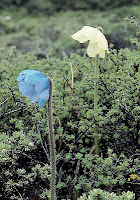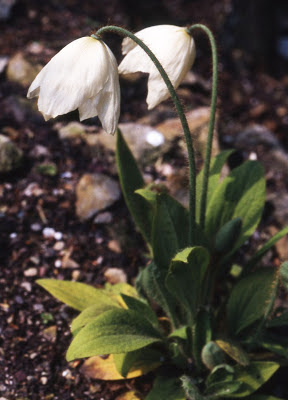Meconopsis Visual Reference Guide. Includes Photos, Taxonomy And Cultivation Information.

Friday 21 January 2005
Meconopsis henricii - Photos In The Wild
Meconopsis henricii
Taxonomy
(Sichuan and Kansu). A purple flowered relative of the M. lancifolia type. It has large purple flowers and orange to pale yellow anthers. The character which distinguishes it from all other Meconopsis (except M. sinomaculata to which it is clearly closely related) is that the bases of the purple filaments are dilated. Two forms are described var genuina which is multiscapose and var psilonomma with only 1 or 2 large outward facing flowers. Has been recently grown from seed but like many of the purple Chinese M. horridula relatives likely to be difficult until we understand the needs better.
Cultivation
Map Location
View Meconopsis World henricii in a larger map
Thursday 20 January 2005
Meconopsis x Harleyana - Photos In The Wild
Meconopsis x Harleyana
Taxonomy
A naturally occurring cream hybrid with M. simplicifolia in the east Himalaya. Has also been produced in cultivation. A rare plant.
Cultivation
Wednesday 19 January 2005
Meconopsis grandis - Photos In The Garden
Meconopsis grandis - Photos In The Wild
Meconopsis grandis
Taxonomy
East Nepal, Sikkim, Bhutan, Tibet (largest flowers) and Arunchal Pradesh. There is an outlying population in West Nepal. The most breathtaking of all the Meconopsis. The leaves are characteristically different from M. betonicifolia and the flowers can be up to 25 cms. across in some forms. It is very variable in its range in the Himalayas and may yet be divided into sub species or varieties. The colour can vary from brilliant sky blues to muddy purples and the flowers from open to cup shaped. There is a great deal of information on this species and M. betonicifolia on the website of the Meconopsis Group as well as a huge amount of information on hybrids and strains of these plants.
February 2011. Chris Grey-Wilson has just written an article in SIBBALDIA, the Journal of Botanic Garden Horticulture No. 8 on Meconopsis grandis - The true Himalayan blue poppy. This is a well researched article with a wealth of historical detail and a section on cultivation wriiten by John Mitchell of the Royal Botanic Gardens in Edinburgh. Dr. Grey-Wilson has divided M. grandis into 3 sub-species. M. g. grandis is found in East Nepal especially to the SE of Everest. This has been collected many times and does still exist in cultivation (but rarely). Two of these are the form known as KEKE (Kew Edinburgh Kanchenjunga Expedition) - this is a robust plant with very large flowers (18 cm across) and 'Sikkim Form' which is much dwarfer,smaller flowered and less floriferous with narrow leaves.This has very bristly seed pods even when mature. The best known of all M. grandis is L and S 600 is placed in M.g. orientalis (incorrectly but better known as GS 600), it also includes Betty's Dream Poppy named after George Sherriff's wife who recounted the story of it's finding to me many years ago at Ascrievie when I met her. This story has been questioned but is undoubtedly true. One of the best features that can be used to distinguish the plants that come from north and north east Bhutan, NW Arunachal Pradesh (Assam) as well as just over the border into Tibet (Cho La and Po La) is smooth seed pods. This subspecies has recently been recollected by Peter Cox (Glendoick) and party and is in cultivation. Finally in West Nepal from the Jumla region is a very outlying population called M.g. jumlaensis. This has been rarely collected and is a small plant with similarities to M. g. grandis which has smooth seed pods and is only 35 cms tall at a maximum.
Cultivation
This is straight forward species that needs treating much like M. betonicifolia. The problem lies in the seed. Much offered commercially is probably not this species but fertile hybrids like Lingholm (one might add here that Lingholm at its best is superlative and really unbeatable unless you like collecting named varieties) I have grown M. grandis for many years but here on the east coast of Scotland it is difficult if a succession of dry summers occurs. In Caithness it grows well, increases vegetaively and I have so far lost none of the big blue poppies grown there. I have several plants of the 'Sikkim Form' and KEKE that grow close together. They do not set seed each year but most years I harvest some. Very often this seed does not germinate well. I suspect that what appears to be good seed from species stressed during the growing season may have a poor germination rate. As far as I have proof the only Meconopsis species that is self fertile is M. superba and it may be that in many gardens only a single plant of the true species of M. grandis exists. There is no doubt that a cool northern garden is required to get seedlings to grow on to mature multicrowned perennial plants and even areas where Meconopsis are reasonably possible seedlings will tend to flower in the second year and die and I have always doubted the advice about removing flowers. If they are happy they will thrive and become polycarpic, if not they will die. Best probably to flower several plants and get a seed set then retry the seedlings somewhere cooler.
Map Location
View Meconopsis World grandis in a larger map
Tuesday 18 January 2005
Meconopsis gracilepes - Photos In The Wild
Meconopsis gracilepes
Taxonomy
Khorlak region of central Nepal. Evergreen monocarpic similar to M. dhwojii but with more delicate and evenly divided leaves. It lacks the purple pigment spots on the leaves of it’s close relative. Taylor described it as most similar to M. robusta and M. longipetiolata.
Cultivation
No reason to suppose it is any different from the other relatively easy evergreen monocarpics but true wild collected seedlings need to be grown in isolation or they will hybridise. 35 years ago plants in the St. Andrews Botanic Garden (from cultivated seed) showed a more delicate leaf structure and lobbing compared to the rather coarser M. dhwojii. Recent seed collected in the wild purported to be this species showed a very similar growth habitat to M. dhwojii as well as showing some purple leaf spotting on a proportion of the plants. Ref. Curtis Botanical Magazine (2002) 23,176.
Map Location
View Meconopsis World gracilipes in a larger map
Monday 17 January 2005
Meconopsis georgei
Taxonomy
( Related to M. horridula ) A localized plant from NW Yunnan. Simply put this is a yellow flowered M. prattii with a raceme and the lower flowers arising from the axils of the stem leaves. A yellow form of M. horridula was decribed by Taylor in 1949 when he visited SE Tibet with Ludlow and Sherriff as M. horridula lutea.
Cultivation
Forrest’s (after whom this was named) collectors sent home seed but no success was recorded.
Map Location
View Meconopsis World georgei in a larger map
Sunday 16 January 2005
Meconopsis ganeshensis
Taxonomy
A newly described evergreen monocarpic species by C Grey-Wilson related to M. dhwojii with red flowers not in cultivation and though close Kathmandu, it is in a remote area. Ref. Curtis Botanical Magazine (2002) 23,176.
Cultivation
Map Location
View Meconopsis World in a larger map
Saturday 15 January 2005
Meconopsis florindae
Taxonomy
Single locality (Tra La) in SE Tibet from woodland at around 3,500 metres. Effectively a yellow flowered M. lyrata. There is very good image of this plant on page 121 of the Alpine Plants of China edited by Zhang Jingwei (Chang King-wai) published by Gordon and Breach, New York in 1982 isbn 0-677-60190-5. I have always been suspicious of yellow plants in a group that is normally all blue. Crosses between a blue species and a yellow one (in many cases the M. integrifolia/ M. pseudointegrifolia group) are always a pale yellow. The plant illustrated, particularly the seed pod reminds me of M. integrifolia. Crosses of blue species ( like M. betonicifolia and M integrifolia) are fertile. New species can evolve by hybridisation and maybe one day this species can be tested using modern genetical techniques to detect it's hybrid origin.
Cultivation
Map Location
View Meconopsis World florindae in a larger map
Friday 14 January 2005
Meconopsis forrestii - Photos In The Garden
| See species taxonomy account. I am not convinced this plant fits with M. forrestii but equally not sure what else it would be. Grown from seed collected wild in Sichuan and identified as this species ( but most collected seed of this species has been wrongly named ). |
Meconopsis forrestii
Taxonomy
( Close relative of M. horridula ) A localized plant from Yunnan and Adjacent Sichuan. Tall leafless stems with a few 4 petalled flowers on the top from pale blues to purple. Filaments are purple and anthers are orange. The fruits are characteristic in being tall (up to 7-8 cms) thin and sparsely bristly.
Cultivation
Seed purportedly of this has been available recently and Forrest sent much home which was not brought to flowering. Another of these Chinese plants that we really have yet to learn how to grow (q.v. M lancifolia).
Map Location
View Meconopsis World forrestii in a larger map
Thursday 13 January 2005
Meconopsis x finlayorum
Taxonomy
This is a hybrid between M. integrifolia and M. quintuplinervia and produced in the garden by the Knox-Finlay’s at Keillour Castle in Perthshire. It has been produced since by the Stone’s at Fort William who named it Askival Ivory and those illustrated were produced by the webmaster. They were perennial and of perfect size, balance and shape. I have tried for many years to cross M. integrifolia with M. punicea to produce a miniature pink plant but never have had seed set. There are few wild hybrids (all mentioned) but dozens produced in cultivation. These have been made between all sorts of unlikely species including reputedly what was M.cambrica. These hybrids occur between plants where chromosomes do not match including crosses between M. betonicifolia and both the evergreen monocarpics and the ‘horridula’ group. The progeny is usually sterile but they can sometimes be perennial when at least one parent was monocarpic. Hybrids may be more common in the wild than we think when several species grow together.
Cultivation
This was a delightful species and could be divided. I am not sure if it is currently in cultivation.
Subscribe to:
Posts (Atom)



































